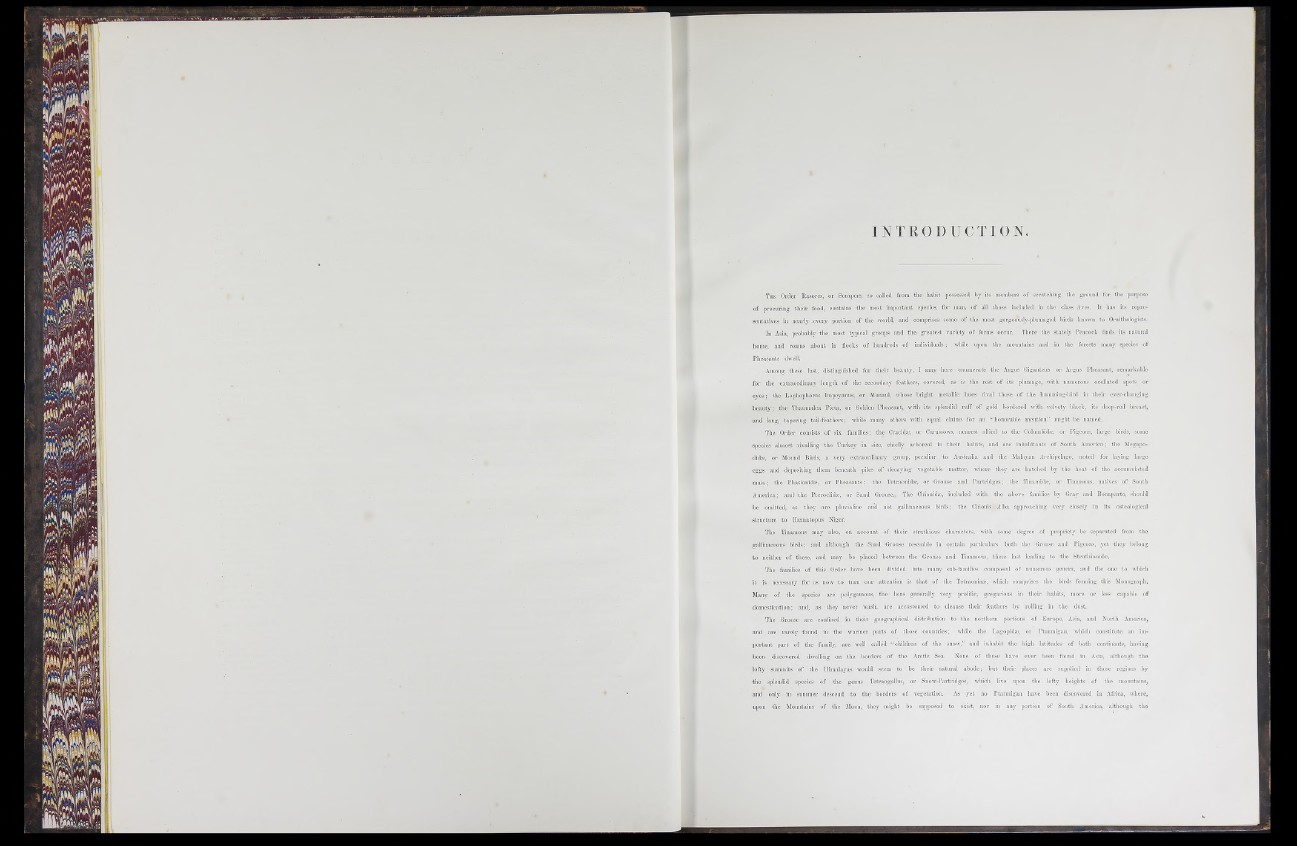
I N T R O D U C T I O N .
Tiik Oi-clci- Rasorcs, or Scrapci-s, so called from tlic habit posscs-scd by its moinbcrs of scratciiiiig tlio ground for tlie purpose
of procuring their food, contains the most important species, for man, of all those included in the class Avcs. It has its I'cprc-
sentatives in nearly every portion of the world, and comprise? some of the most gorgcbnsly-plumngod bii'd.s known to Ornithologists.
In Asia, probably the most typical groups and the greatest variety of forms occur. There tlic sta te ly I’eacock finds its natural
homo, and roams about in flocks of hundreds of individuals ; while upon the mountains and in the forests many species of
Pheasants dwell.
Among those last, distingnishod for their boiiuty, I may here cinimeratc the Argus Oigantcns or Argus Pheasant, remarkable
for the extraordinary length of the secondary feathers, covered, as is the rest of its plumage, iritli nnincrous ocellatcd spots or
eyes; the Lophophorus Inipcyanus, or Moiiaul, «'hose bright metallic hue? rb a l those of the huimning-biid in their ever-changing
beauty; the Tliaunialco Picta, or Golden Pheasant, ivith its s|)lendid ruff of gold bordered with velvety black, its dccp-icd breast,
and long, tapering tail-feathers; while many others with equal claims for an “ honorable mention" might be named.
The Order consists of six families; the Cracidm, or Cnrassows, nearest allied to tlie Columljidai, or Pigeons, lai'go birds, some
species almost rivalling the Turkey in size, chiotly arboreal in their habits, and are inhabitants of South America; the Megapo-
did.-c, or Mound Birds, a very extraordinary grouii, peculiar to Australia and the Malayan Archipelago, noteil for laying largo
eggs and depositing them bciioath piles of decaying vegetable matter, whore they arc hatched by the heat of the accmmilated
mass; the Phasianida:, or Pheasants; the Totraonidio, or Grouse and Partridges; the Tiiiamidio, or Tinamous, native.? of South
America' and the Pteroclidm, or Sand Grouse. The Cliionidic, included with the above families by Gray and Bonaparte, should
bo omitted, as they arc pliivialiiie and not gallinaceous birds; th.c Cliioitis Alba approaching I’ory closely in its osfeological
Btructuro to lIa3niatopn,? Niger.
The Tinamous may also, on account of their strutliious chavactoi-s, with some degree of |u-opricty bo separated from the
gallinaceous biids; and altliough the Sand Grouse resemble in certain particulars botli the Grou.se and Pigeons, yet tlicy belong
to neither of these, and may be placed botwocii the Grouse and Tinamous, these last leading to the Strutliionida:.
The families of this Order have been diiridcd into many snb-families composed of luimorous genera, and the one to «liich
it is necessary for as now to turn our attention is tliat of the Tctraoninic, wliich comprises the bii-cl.< forming tliis Monograph.
Many of the species arc polygamous, the liens generally very prolific, gregarious in their habits, more or less capalilo of
domestication; and, as they never wash, arc accustomed to cleanse their featlicrs by rolling in the dust.
ifinod in their goograpliical distribution to the novtlievn portions of Europe, Asia, and North America,
II the warmer parts of those countries; while the Lagopida:, or Ptarmigan, which constitute an imohildren
of the sno'v," and inhabit the high latitudes of both continents, liaiing
the Arctic Sea. None of these have ever been found in Asia, although tho
The Grouse are <
aiul arc rarely found
portaut part of the family, arc well called
been discovered dwelling on the borders <
lofty snniniits of tho Himalayas would seem to he their natural abode; but their ¡daces arc su]iiilicd in those regions by
the splendid species of the genus Tetraogallus, or Snow-Partvidgcs, which live upon the lofty heights of the nionntaiiis,
and only in snnimcv descend to the borders of vegetation. As yet no Ptarmigan have been discovered in Africa, «'hero,
upon the Mountains of tlie Moon, tlioy miglit bo siqiposed to exist, nor in any portion of South America, although the